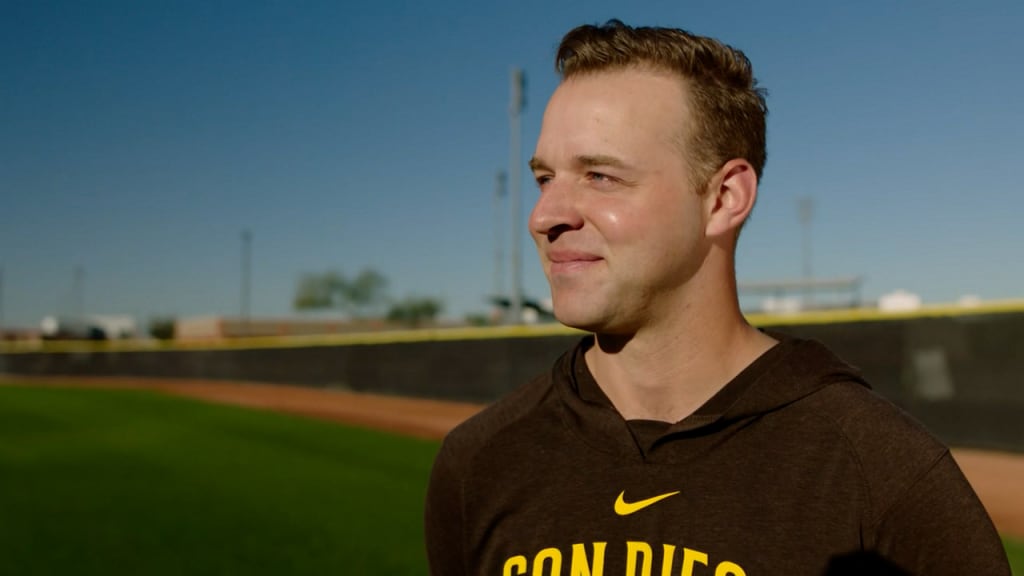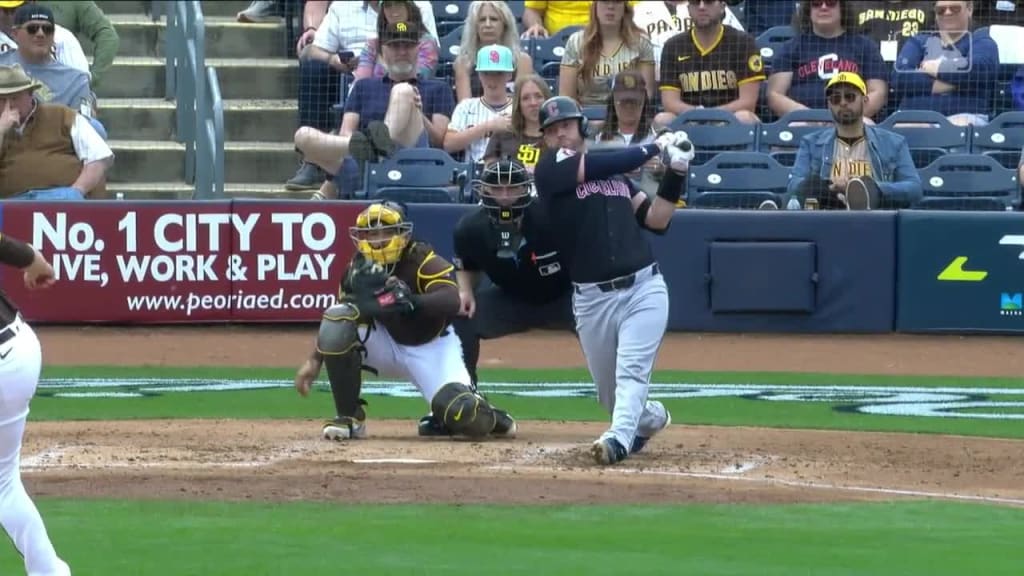Replacing a Cy winner? This reliever-turned-starter is ready for it
This browser does not support the video element.
Michael King quickly realized during his 2020 rookie season with the Yankees that he wasn't ready to be a big league starter. “I basically only had a sinker. … So I felt like I got exposed once I got to the big leagues,” King told MLB.com. But a lot has changed in the past four years. King thinks he's much better equipped to handle the job now, and he'll get the opportunity to prove it in 2024.
Granted, King doesn't exactly have much room for error as he tries to make the difficult transition from relieving to starting.
The Padres' rotation will have several new faces this season, but for all intents and purposes, King is the one being counted on to replace two-time Cy Young Award winner Blake Snell, who won 2023 National League Cy Young honors with a 2.25 ERA before reaching free agency. He’s also facing the expectations that come from being one of the top prizes in the trade package for superstar outfielder Juan Soto.
King, though, isn't sweating the pressure. This is right where he wants to be.
This browser does not support the video element.
The 28-year-old has made 96 of his 115 career appearances in the Majors as a reliever and enjoyed great success pitching out of the bullpen for the Yankees in the past two years, but he has longed for the opportunity to start on a full-time basis.
King certainly held his own when given the chance to start late last season, notching a 1.88 ERA with 48 strikeouts and nine walks in 38 1/3 innings over eight starts for the Yankees.
The pitcher King has become bears little resemblance to the one who first arrived in the big leagues.
“The sinker was the only pitch that I knew had good movement and I could command it well," King said. "The slider that I had was awful. Terrible movement. I would try to throw it at the bottom of the zone but leave it hanging a ton. I felt like I was able to get away with flipping a Minor League lineup with just one pitch, because I could command that pitch. Once I got to the big leagues … I could not flip a lineup with one pitch."
King points to two pivotal adjustments that transformed his arsenal and could put him in position to thrive as a starter moving forward.
1. He finally found the right breaking ball
Over the past few seasons, we’ve seen more pitchers begin to throw a sweeper, a type of slider intended to get a great deal of horizontal movement.
King was an early adopter, and he credits another two-time Cy Young Award winner, Corey Kluber, with teaching him the pitch when they were teammates with the Yankees in 2021, back when the pitch wasn't even widely referred to as a sweeper yet.
“I was really trying to develop a slider, because I felt like it would complement all the movement I have arm-side with my sinker,” King said. “I tried [Adam] Ottavino’s slider and I couldn’t do it. I tried Gerrit [Cole]’s slider and I couldn’t do it. I was really messing around with a bunch of stuff.
"It wasn’t until Kluber taught me his in ‘21, and it was [called] the 'Kluber Ball' but now it's the sweeper. Everybody's got it now, but at the time Kluber was one of the only ones [who threw it]. ... The cues that he gave me and the grip that he gave me just made sense.”
King now features one of the sweepiest sweepers in the Majors, generating 3.4 more inches of horizontal break than an average sweeper.
You can see in the graph below just how much more horizontal movement his sweeper gets compared to his old breaking ball, which Statcast classifies as a curveball.
Statcast’s new bat-tracking metrics, which will be available to the public starting with the 2024 season, show just how difficult the pitch can be to hit. Batters not only swung and missed at King's sweeper often in 2023 (39.5% whiff rate), but when they missed, it was typically by a wide margin. In fact, only two pitch types generated bigger whiffs, on average.
Largest average whiff distance by pitch type in 2023
Minimum 25 swings-and-misses vs. that pitch
- Blake Snell's curveball -- 10.4 inches
- Tyler Glasnow's curveball -- 9.6 inches
- Michael King's sweeper -- 9.1 inches
- Luis Garcia's slider -- 8.8 inches
- José Leclerc's slider / Alek Manoah's slider -- 8.4 inches
King also gets a ton of horizontal movement in the opposite direction with both his sinker and his changeup, so batters have to worry about covering a lot of distance from side to side in any particular plate appearance.
King’s average horizontal movement, 2023:
- Sweeper: 18.0 inches of glove-side break (+3.4 inches vs. average)
- Sinker: 16.5 inches of arm-side run (+1.3 inches vs. average)
- Changeup: 17.4 inches of arm-side run (+2.8 inches vs. average)
Of all the pitches King threw last season, 43.5% of them moved at least 17 inches -- the width of home plate -- either to his glove side or arm side. Despite spending much of 2023 as a reliever, he threw the eighth-most pitches with at least 17 inches of glove-side break and the 18th-most pitches with at least 17 inches of arm-side run in all of MLB.
2) He started throwing more four-seamers
The sinker isn’t the only fastball type King uses. He also throws a four-seamer, and he has increased his usage rate on the pitch to 22.6% over the past two seasons after using it sparingly (8.0%) in 2020-21. In turn, he has decreased his reliance on his sinker, dropping his usage rate on sinkers to a career-low 33.5% in 2023.
The tweak has not only helped King find greater balance with his pitch mix but also with his location.
While the righty uses his sinker-sweeper combo to target the corners, he primarily throws his four-seamer up in the strike zone, giving batters a different look. The pitch has proven to be an effective offering even with the increased exposure, limiting opposing hitters to a .208 batting average and a .323 slugging percentage since the beginning of 2022.
Meanwhile, King’s changeup -- which he typically locates down in the zone -- has flourished as well, particularly against left-handed batters. Over the past two seasons, he has held left-handed batters to a .105 batting average and .132 slugging percentage in 76 at-bats ending on changeups.
And while most pitchers have one or two offerings they lean on to put batters away and get K’s, King has shown the rare ability to do it with all four of his pitches. Last season, King and Max Scherzer were the only two pitchers in the Majors who posted a strikeout rate of 26% or higher on as many as four different pitch types (minimum 50 plate appearances ending on that pitch type).
In other words, King has come a long way from the days when he only had one pitch he felt confident throwing. Now, he has four.
Having diversified his repertoire, King has become less predictable and can target all four quadrants of the zone, something he thinks will help him excel as a starter.
“Now I have both sides [horizontally], one [pitch] going up and that [changeup] coming [down],” he said. “And I think that that allowed me to get ahead of the count with pitches that I didn’t want to strike you out with or get you out with. And now because I’m commanding all four of these pitches, if your scouting report was I’m going to get you out with a sweeper, I can throw two other pitches to get to 0-2, and you still haven’t seen my sweeper, and then I execute that and now you’re done.
“If I wanted to get you out with a sinker four years ago, I had to throw you three straight sinkers that were dotted to get you out.”
This browser does not support the video element.
Of course, while King's arsenal could allow him to have immediate success as a starter for the Padres in 2023, it remains to be seen how his body will hold up under the rigors of a full year in a big league rotation.
King threw 104 2/3 innings last season, establishing a new career high by more than 41 frames. He did so after his 2022 season was cut short in July when he needed to undergo surgery to repair a fracture in his throwing elbow.
However, he isn't concerned about the potential jump in innings. He was sure to mention the success the Padres had converting Seth Lugo from a reliever to a starter just last year. Lugo posted a 3.57 ERA over 146 1/3 innings for San Diego before signing a two-year, $30 million deal (with a $15 million player option in 2026) with the Royals as a free agent.
King said he has faith that the Padres and pitching coach Ruben Niebla know what they're doing. He also thinks being on a starter's routine will help his endurance.
“It’s easier to stay strong throughout a year as a starter because you’re on such a routine," King said. "There were days where I had to pitch back-to-back and then I’m supposed to lift and then I’m supposed to be hot the next day. And I’m like just tearing my body down right now. I don’t get those recovery days where I know I’m healthy."
Plus, the way King looks at it, he has already shown the ability to stay healthy in a starting role, even if it wasn't in the Majors. The righty threw 149 innings in the Minors in 2017 -- his first full professional season -- and 161 1/3 the year after that.
“I know I can do it," he said. "All I gotta do is just go do it because I just haven’t been given the opportunities to do it the last few years. So that’s how I’m approaching it from a health standpoint. My body has stayed healthy if I wanted to actually do that. And I’m just going to go from 104 [2/3 innings] to 180-200 [innings] this year. That’s just how the mindset is.”
Reporting from MLB.com's AJ Cassavell contributed to this story.

